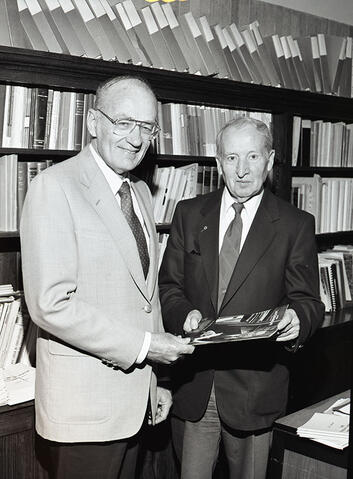
Zone du titre et de la mention de responsabilité
Titre propre
Dr. Stanley Barber and Dr. J.W.T. Spinks
Dénomination générale des documents
- Document graphique
Titre parallèle
Compléments du titre
Mentions de responsabilité du titre
Notes du titre
Niveau de description
Pièce
Cote
Zone de l'édition
Mention d'édition
Mentions de responsabilité relatives à l'édition
Zone des précisions relatives à la catégorie de documents
Mention d'échelle (cartographique)
Mention de projection (cartographique)
Mention des coordonnées (cartographiques)
Mention d'échelle (architecturale)
Juridiction responsable et dénomination (philatélique)
Zone des dates de production
Date(s)
-
May 1986 (Production)
Zone de description matérielle
Description matérielle
1 photograph : b&w ; 6 x 5 cm
1 negative : b&w ; 6 x 5 cm
Zone de la collection
Titre propre de la collection
Titres parallèles de la collection
Compléments du titre de la collection
Mention de responsabilité relative à la collection
Numérotation à l'intérieur de la collection
Note sur la collection
Zone de la description archivistique
Nom du producteur
Historique de la conservation
Portée et contenu
Dr. J.W.T. Spinks (right), president emeritus, and Dr. Stanley Barber, professor of Chemistry, Purdue University, in Dr. Spinks' office in the Thorvaldson Building.
Bio/Historical Note: Dr. Stanley L. Barber was born at Wolseley, Saskatchewan. He took his public schooling and three years of high school through correspondence at Westfield School, a rural school near the home farm. He graduated with a BSA and an MSc in 1945 and 1947 respectively, from the University of Saskatchewan. As a part of his research program that was supervised by Drs. J.W.T. Spinks and John Mitchell, the first radioactive-P field fertilizer experiment in the world was set out on the Agar farm near Floral. This experiment, which was highly successful, stimulated worldwide interest in isotope dilution technology and showed the role that radio-isotopes could play in evaluating fertilizer nutrient management practices. The results of thousands of similar experiments both here and elsewhere led to dramatic improvements in fertilizer management practices. Dr. Barber obtained his PhD in Soil Chemistry from the University of Missouri in 1949, and joined the Agronomy Department, Purdue University, that same year. Barber had a distinguished research career that has resulted in major breakthroughs in knowledge of soil fertility and plant nutrition. Dr. Barber was made a Fellow of the Indiana Academy of Science, the American Society of Agronomy, and the Soil Science Society of America. He was a recipient of the Soil Science Society of America's Science Award given to the person making the greatest contribution to Soil Science in any one year. Dr. Barber received the American Society of Agronomy's Agronomic Research Award and the Agronomic Achievement Award. He wrote the book "Soil Nutrient Bio-availability," published in 1984. Dr. Barber retired in 1991, and died in 2002 in Columbus, Ohio.
Zone des notes
État de conservation
Source immédiate d'acquisition
Classement
Langue des documents
Écriture des documents
Localisation des originaux
Disponibilité d'autres formats
Restrictions d'accès
There are no restrictions on access.
Délais d'utilisation, de reproduction et de publication
Photographer: DAVS
Copyright holder: University of Saskatchewan
Other terms: Responsibility regarding questions of copyright that may arise in the use of any images is assumed by the researcher.

